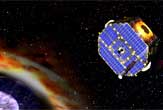Knot in Mystery Ribbon at Solar System's Edge Unravels

The unraveling of a knot in a mysterious energy ribbon shows that the edge of our solar system is a much more dynamic place than previously thought, according to new research.
NASA's Interstellar Boundary Explorer spacecraft has revealed quickly changing conditions near the heliosphere, a protective bubble that shields our solar system from powerful, damaging cosmic rays. The observations, which include the loosening of a knot in a strange energy ribbon, could help scientists better design long-range space missions, researchers said.
The findings result from a new set of "all-sky" maps IBEX has produced of our solar system's interaction with the galaxy. IBEX creates these maps by measuring and counting particles called energetic neutral atoms (ENA's), which are created in an area of our solar system known as the interstellar boundary region.
In this region, charged particles from the sun flow outward far beyond the orbits of the planets and collide with material between stars. These collisions cause these energetic neutral atoms to travel inward toward the sun at velocities ranging from 100,000 mph to more than 2.4 million mph.
In October 2009, IBEX produced its first all-sky map, which revealed a mysterious bright ribbon of ENA's zipping toward the sun from the edge of the solar system.
This discovery was unexpected to scientists, because the ribbon of bright emissions did not resemble any previous theoretical models of the region.
This new second set of all-sky maps, which was compiled based on six months of observations, shows a bright knot in this ribbon appearing to spread out. This result shows that the area around the heliosphere, which helps shield the solar system from highly energetic cosmic rays, can change very quickly, scientists said.
Get the world’s most fascinating discoveries delivered straight to your inbox.
The new findings were published this week in the Journal of Geophysical Research - Space Physics, a publication of the American Geophysical Union.
"Our discovery of changes over six months in the IBEX ribbon and other neutral atoms propagating in from the edge of our solar system show that the interaction of our sun and the galaxy is amazingly dynamic," said David J. McComas, IBEX principal investigator at the Southwest Research Institute in San Antonio. "These variations are taking place on remarkably short timescales."
The IBEX spacecraft was launched in October 2008. Its science objective was to discover the nature of the interactions between the solar wind and the interstellar medium at the edge of our solar system.
"This situational awareness provided by IBEX shows our place in space is not constant," said Dick Fisher, director of the Heliophysics Division in NASA's science mission directorate in Washington. "Better understanding of the dynamic environment of space is vital for successful planning for future exploration."
- Images: Sun Storms
- Video: NASA's IBEX: Exploring the Solar System's Edge
- Mysterious Ribbon at the Edge of Solar System Explained
This article was provided by SPACE.com, a sister site to LiveScience.



